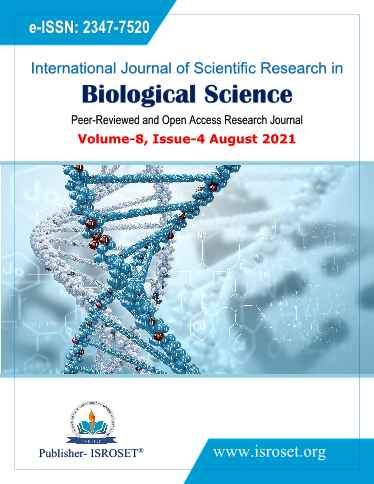Comparative Study & Efficacy of Commonly Used Disinfectant against Human Pathogens
Keywords:
Disinfectants, Kirby-Bauer method, S. aureus, Klebshiella, Pseudomonas, BacillusAbstract
Disinfection is the process of elimination of virtually all pathogenic organism on inanimate objects & surfaces thereby reducing the level of microbial contamination to safe level.The study aimed to evaluate sensitivity of some clinical organisms used for the tests are S. aureus, Klebshiella , Pseudomonas, E. coli, Bacillus with the activity of some selected commercial disinfectants used are Dettol, Lysol, Ultraclean, Phenyl & Phenol. All the disinfectants used in this study have bactericidal effect against the test organisms whereas Phenol Coefficient test was carried out to compare sensitivity of disinfectants to that of phenol under experimental method so as to determine the disinfectant efficacy. Phenol & Dettol showed highest antimicrobial activity against all test organisms. Ultraclean also showed high antimicrobial activity except Pseudomonas aeuroginosa. Phenol coefficient test was used for Staphylococcus appear as Lysol is the most potent disinfectant than all other disinfectant and for Bacillus appear as Dettol is more effective than other disinfectant used in this study.
References
Lineback, C.B, Nkemngong, C.A et al. “Hydrogen peroxide and sodium hypochlorite disinfectants are more effective against Staphylococcus aureus and Pseudomonas aeruginosa biofilms than quaternary ammonium compounds”, Antimicrob. Resist. Infect. Control 7, 154, 2018.
Quinn, M.M.; Henneberger, P.K.; Braun, B.; Delclos, G.L.; Fagan, K.; Huang, V.; Knaack, J.L.; Kusek, L. National Institute for Occupational Safety and Health (NIOSH); National occupational research agenda (NORA) cleaning and disinfecting in healthcare working group; et al. “Cleaning and disinfecting environmental surfaces in health care: Toward an integrated framework for infection and occupational illness prevention” , Am. J. Infect. Control, 43, pp no. 424–434, 2015.
Olowe,O.A, A.B.Olayemi, K.T.Eniola and O.A.Adeyeba “Antimicrobial activity of some selected disinfectants regularly used in hospitals”,Afr.J.Clin.Exp.Microbiol., 5: pp no. 126-130,2004.
Kennedy, J. and Bek, J. “Selection and use of Disinfectants. Braska Cooperatibe extension”, 40 pp no. 5-8 ,1998.
Ascenzi J.M.,“Gluteraldehyde-based disinfectants In:Handbook of disinfectants and Antiseptics. Ascenzi,J.M.,(Ed.),N.Y.:Marcel Dekker Inc” ,pp no.111-132, 1996.
Gerald,M and A.R.Denver, “Antiseptics and disinfectants:Activity, action and resistance” Clin.Microbiol.Rev.,12: pp no. 147-179, 1999.
Grota P, Ackiss EA. “ Association for Professionals in Infection Control and Epidemiology. APIC text of infection control and epidemiology Washington, DC: APIC”; 2014.
Paul, M.; Shani, V.; Mucihtar, E.; Kariv, G.; Robenshtok, E.; Leibovici, L, “Systematic review and meta-analysis of the efficacy of appropriate empiric antibiotic therapy for sepsis” Antimicrob. Agents Chemother, 54, pp no. 4851–4863. 2010 [CrossRef].
Laxminarayan, R.; Duse, A.; Wattal, C.; Zaidi, A.K.; Wertheim, H.F.; Sumpradit, N.; Vlieghe, E.; Hara, G.L.; Gould, I.M.; Goossens, H.; et al. “Antibiotic resistance-the need for global solutions” Lancet Infect. Dis. 13,pp no. 1057–1098, 2013 [CrossRef].
West, A.M.; Teska, P.J.; Lineback, C.B.; Oliver, H.F, “ Strain, disinfectant, concentration, and contact time quantitatively impact disinfectant efficacy” Antimicrob. Resist. Infect. Control, 7, 49, 2018.
Burdon, D.V and Whitby, J.L, “Contamination of hospital disinfectants with Pseudomonas spp.” Brit. Med. J. 2: pp no.153-157, 1967.
Segbetan, A,O., Alausa, K.O and Sobayo, E.L, “ In – use quality control of hospital antiseptics” J. Med and Pharm. Markeing 4: pp no.251-253, 1990.
French, G.L and Phillips, “ Antimicrobial resistance in hospital flora and nosocomical infection. Hospital Epidemiology and infection control”, Williams and Wilkins, Baltimore, MD (May hall,C.Ed), pp no. 980-990, 1996.
Hand washing liaison group, “ Hand washing a modest measure with big effects”, Brit. Med. J. 318, 686, 1999.
Moorer, W. R, “Antiviral activity of alcohol for surface disinfection”, International Journal of Dental Hygiene, 3: pp no.138 – 142, 2003.
Downloads
Published
How to Cite
Issue
Section
License

This work is licensed under a Creative Commons Attribution 4.0 International License.
Authors contributing to this journal agree to publish their articles under the Creative Commons Attribution 4.0 International License, allowing third parties to share their work (copy, distribute, transmit) and to adapt it, under the condition that the authors are given credit and that in the event of reuse or distribution, the terms of this license are made clear.







